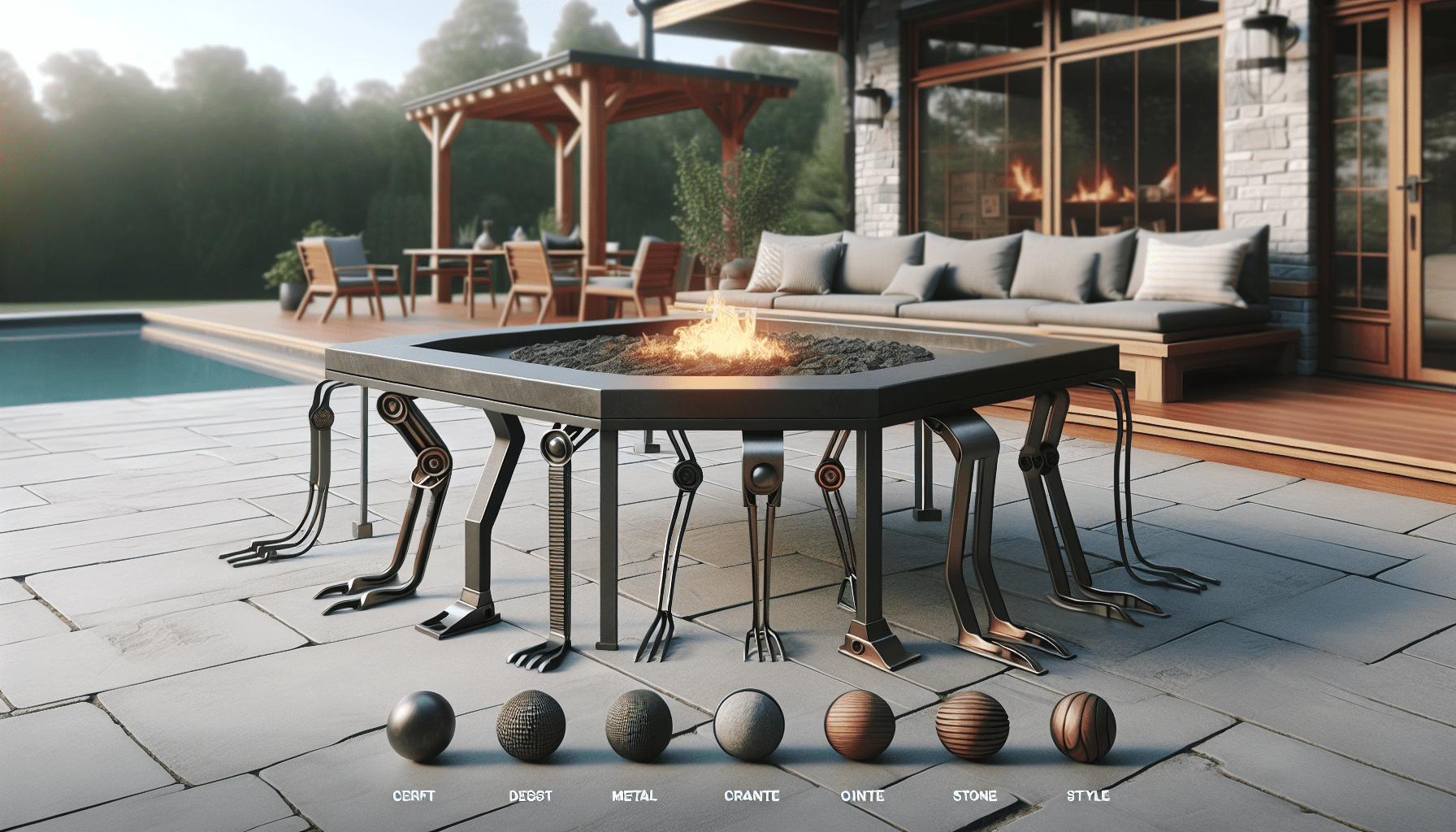Does the thought of gathering around a cozy fire pit sound like the perfect addition to your outdoor space, but you’re unsure how to keep it secure and stylish? Choosing and installing fire pit legs can seem like a daunting task, but with the right guidance, you’ll be well-equipped to make informed decisions that enhance both stability and style.

Why Fire Pit Legs Matter
When you’re looking at fire pits, the legs might not be the first component you think about. However, they play a crucial role in safety and aesthetics.
Stability: The Foundation of Safety
The stability of your fire pit is paramount. Too often, improper installation leads to accidents, something as terrifying as a tipped-over fire pit. By choosing the right legs, you ensure that your fire pit stands firm, even on uneven surfaces.
Style: Aesthetics That Complement Your Space
The right fire pit legs can be a subtle complement or a bold statement. Whether you’re going for a modern look with sleek, metallic legs or a rustic vibe with wrought iron, the legs can amplify your outdoor space’s visual appeal.
Types of Fire Pit Legs
There are several types of fire pit legs you can choose from. Each has its own benefits and potential drawbacks. Here’s a rundown to help you decide.
| Type of Leg | Material | Key Features | Pros | Cons |
|---|---|---|---|---|
| Fixed Legs | Metal/Stone | Permanent installation, high stability | Very stable, durable | Limited mobility, complex installation |
| Adjustable Legs | Metal/Composite | Adjustable height, flexible installation | Versatile, easy to level | Less stable than fixed, can wear out |
| Wheeled Legs | Metal | Mobility feature, easy to move | Easy to relocate, convenient | Less stable, possible wear on wheels |
Fixed Legs
Fixed legs are a more permanent solution, often made from durable materials like stone or metal. These are fantastic for ensuring a stable and sturdy fire pit. However, keep in mind that the complexity of installation can be higher with this option.
Adjustable Legs
Adjustable legs are generally crafted from metal or composite materials. These are perfect if your outdoor space is uneven. They also offer flexibility if you decide to move your fire pit slightly for a better view or configuration.
Wheeled Legs
For those who prioritize flexibility, wheeled legs are a great choice. These allow you to move your fire pit around with ease. Be aware, though, that mobility can come at the cost of stability, especially on uneven surfaces.
Choosing The Right Material
The material of your fire pit legs will affect durability, maintenance, and style. Here are the common materials used and what you can expect from each.
Metal: Modern and Durable
Metal legs, often made from stainless steel or iron, are both durable and stylish. They give a modern touch to your fire pit and require minimal maintenance. However, they can be prone to rust if not properly treated, especially if you live in a humid area.
Stone: Natural and Sturdy
Stone legs lend a natural, classic look to your fire pit. They are incredibly sturdy and can handle high temperatures without cracking. However, they are also more challenging to install due to their weight and permanence.
Composite: Versatile and Lightweight
Composite materials, often made from a blend of resins and fiberglass, offer a lightweight option that is still fairly durable. They can be molded to mimic the appearance of stone or metal but without the heft. The trade-off is that they might not be as durable over time.

Installation Guide
Let’s get practical. Installing fire pit legs can be a straightforward process if you follow these steps closely. Here’s a simple guide to get you started.
Tools and Materials Needed
Before you start, make sure you have all the necessary tools and materials:
- Drill
- Screws and bolts
- Level
- Measuring tape
- Safety glasses
- Gloves
Step-by-Step Installation
-
Preparation: Clear the area where you’re planning to install the fire pit. Ensure the ground is as level as possible.
-
Measure and Mark: Using the measuring tape, mark the spots where the legs will be attached. Ensure these marks are symmetrical for balanced support.
-
Drilling Holes: If your fire pit frame doesn’t come with pre-drilled holes, use your drill to create them at the marked spots.
-
Attach Legs: Align the legs with the holes and secure them using screws and bolts. Make sure each leg is tightly fastened.
-
Leveling: Use a level to ensure that the fire pit is balanced. Adjust the legs as necessary.
-
Safety Check: Once everything is set up, do a final check to ensure that all components are secure and the fire pit is stable.
Safety Tips
Safety should always be your top priority when dealing with fire pits. Here are some tips to ensure a safe setup:
Proper Ventilation
Ensure your fire pit is in a well-ventilated area to prevent the build-up of harmful gases like carbon monoxide. Never use a fire pit indoors or in an enclosed space.
Safe Distance
Place your fire pit at least 10 feet away from any structures, including your house, shed, or trees. This minimizes the risk of accidental fires.
Fire-Resistant Materials
Install the fire pit on a surface made of fire-resistant materials like gravel, concrete, or stone to reduce the risk of spreading the fire.
Maintenance Tips
To ensure your fire pit and its legs last for years, regular maintenance is key. Here are some simple steps to keep everything in top shape:
Cleaning
Regularly clean the legs to prevent the build-up of dirt and rust. For metal legs, use a wire brush and soapy water. For stone legs, a good rinse should suffice.
Inspections
Periodically inspect the fire pit and its legs for any signs of wear or damage. Tighten screws and bolts as needed to maintain stability.
Weather Protection
If you expect bad weather, consider covering your fire pit to protect it from the elements. This is particularly important for metal legs, which can rust when exposed to moisture.
Enhancing The Aesthetic Appeal
The legs of your fire pit don’t have to be purely functional; they can also be a design feature. Here are some tips to make them a decorative element in your outdoor space.
Paint and Finishes
For metal legs, consider using high-temperature spray paint to give them a fresh, new look. Choose colors that complement your outdoor decor.
Decorative Elements
Incorporate decorative elements like wrought iron scrolls or stone carvings to give a unique and personalized touch to your fire pit.
Outdoor Furniture
Coordinate your fire pit legs with your outdoor furniture to create a cohesive look. For instance, if your furniture has metal elements, matching them with metal fire pit legs can tie the whole look together.
Common Mistakes to Avoid
There are some common pitfalls to watch out for when choosing and installing fire pit legs. Being aware of these can save you time and effort.
Choosing the Wrong Material
Selecting a material that isn’t suitable for your climate or usage can lead to faster wear and tear. For instance, metal might not be the best option if you live in a humid area while stone can be too cumbersome for frequent moves.
Improper Installation
Failing to securely fasten the legs can lead to instability, posing safety risks. Always double-check that all screws and bolts are tightly secured.
Ignoring Maintenance
A lack of regular maintenance can shorten the lifespan of your fire pit legs. Make a routine to inspect and clean your fire pit to ensure it remains in good condition.
The Final Touch
After you’ve chosen and installed the perfect set of fire pit legs, take a step back and admire your handiwork. With the right combination of stability and style, your fire pit will not only be a focal point for gatherings but also a safe and secure addition to your outdoor space.
Choosing and installing the perfect fire pit legs doesn’t have to be overwhelming. By focusing on the right materials, styles, and installation techniques, you’ll create a stable and aesthetically pleasing feature for your patio or backyard. Happy gathering!

